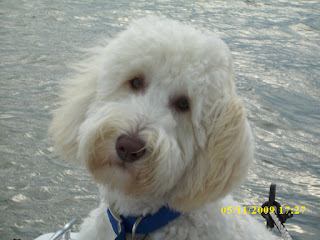The Honda EU3000i generator and roof mounted air conditioner had passed all tests.
I installed Seadek foam on the engine hatch and port walkway including swim steps so the dogs could get traction. I'll finish the rest of the aft patio when time permits.
The aft deck had been converted to a playpen with expanding swing away gates on the sides and a piece of plastic lattice across the stern.
The (blue) dinghy could be successfully stowed on the flybridge as shown above.
I ran out of time and along with the remaining Seadek, the Floscan didn't get installed. I also hadn't finished up a score of other non-essential projects...but if you wait until you're ready - you'll never go.
Fill the freshwater tank, pump out the holding tank, start/check the motor, air up the tires on trailer and van, check lights and brakes. Thankfully Suzy and Sara Jane had already procured and stashed all the food and family type essentials for the trip/cruise, and we were off to the gas station to fill up both the van and boat...on one of the hottest days of the year to an area that was generally even hotter. Forecast was for 100+° 100 miles down the road at Lake Murray. We would meet up with Trey, and SJ at the ramp.
We hardly ever pass up a Rest Area. If nothing else, it's a good time to give everything a once-over and empty the dog.
I was a little concerned about the heat. The tires/wheels on the trailer were mighty warm but not quite to blistering a finger yet. We have no real problems pulling Big Duck, except the Interstate run is up hill and down. The van does work pretty hard on the hills, but we don't expect to go 55 mph; I put her on about 2,600 RPM and let her find her own speed. The gauges on this daytime run showed outside temp at 101°, coolant temp at 205° and trans fluid temp at 195°. I really didn't have anything to compare these to, but they seemed to reflect the ambient temp and work needed to negotiate the hills.
Having help at the ramp was a huge blessing. We experimented to see if we could back in far enough to float Big Duck off the trailer but with the rear bumper of the van under water, although she was light at the stern, she still couldn't be pulled loose. I tried tying her to the dock with Trey pulling the trailer out from under her. No go. We finally reverted to the back her down and lock up the brakes method and she came off without further complaint. I do believe we could have powered her off...we'll try that next time and will also lube the bunks while the trailer is empty.
Lit up the generator and turned on the air conditioner. Put the girls, baby and dogs aboard, untie her and it's out onto the lake we all go.
Stay tuned...
First Family Outing Part B

















